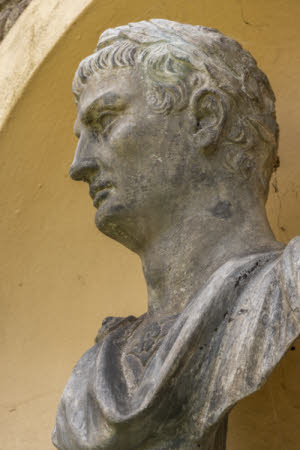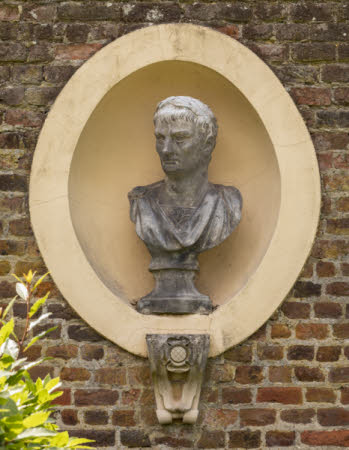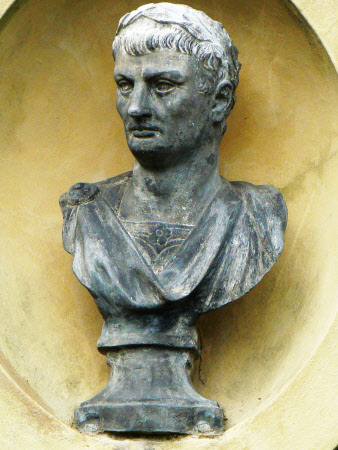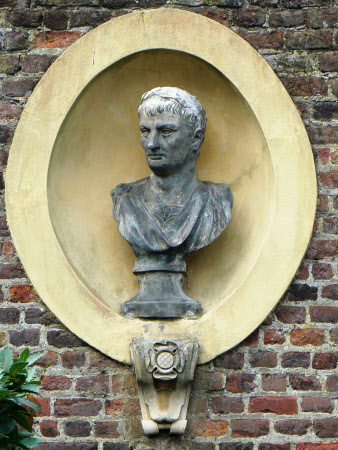A bust of Julius Caesar
workshop of John Besnier (fl.1681)
Category
Art / Sculpture
Date
c. 1670 - 1672
Materials
Lead, Sandstone
Measurements
765 mm (H)435 mm (W)
Place of origin
London
Order this imageCollection
Ham House, Surrey
NT 1140364
Summary
A lead portrait bust of a Roman, probably the dictator Caius Julius Caesar, wearing armour, with a corselet over which is a cloak. One of thirty-eight lead busts made for the garden walls of Ham House in 1671-72, perhaps in the workshop of John Besnier, thirty-six of which survive in niches on the walls and on the north façade of the house.
Full description
A lead portrait bust of a Roman emperor, probably Caius Julius Caesar (100-44 B.C.). He wears armour, with a square-necked corselet, decorated at the centre with a rosette, over which is a cloak, fastened at the right shoulder with a round brooch. He has a laurel wreath in his hair, a noble aspect and looks to his right. Mounted on a plinth, and placed on a sandstone console carved with a four-leafed rosette (the central section a modern replacement), and below a scrolled tongue. The laurel wreath indicates that the bust depicts a Roman emperor, whilst the distinguished and regal treatment would suggest that the subject is Caius Julius Caesar, although he is in this portrait shown a little less gaunt than is usually the case in his portraits. One of the most celebrated figures in Roman history, whose assassination in 44 B.C. led eventually to the crowning of his adopted son Augustus as the first Emperor of Rome, Caesar was a key element in series of the Twelve Caesars. The depiction in the bust possibly derives from the print published in 1634 in Peter Paul Rubens’s series of twelve images of famous men from ancient Greece and Rome. It is one of two busts of the same model at Ham, the other is NT 1140339. They are part of a series of thirty-six lead busts displayed in oval niches in the garden walls and on the north façade of Ham House, probably installed in 1671-72, and recorded in the 1679 inventory of Ham House. The entire series was probably arranged in its present positions along the garden walls and on the north front of Ham House by the 6th Earl of Dysart, as part of improvements undertaken between 1798 and 1803. The busts may well, like other sculpture at Ham House, have been made in the workshops of the Besnier family, perhaps by John Besnier, who received a commission for lead statuary from the Duke of Ormonde in 1681. For a fuller discussion of the garden wall busts and their history and attribution, see NT 1140333. Jeremy Warren January 2022
Provenance
Probably made and installed in 1671-72, to the commission of John Maitland and Elizabeth Murray, 1st Duke and Duchess of Lauderdale. Thence by descent,until acquired in 1948 by HM Government when Sir Lyonel, 4th Bt (1854 – 1952) and Sir Cecil Tollemache, 5th Bt (1886 – 1969) presented Ham House to the National Trust. Entrusted to the care of the Victoria & Albert Museum until 1990, when returned to the care of the National Trust, to which ownership was transferred in 2002.
Makers and roles
workshop of John Besnier (fl.1681), sculptor
References
Avery 2013: Charles Avery, ‘Seventeenth-century Sculpture at Ham House’ in Christopher Rowell, ed., Ham House. 400 Years of History, New Haven/London 2013, pp. 158-77., pp. 172-76



